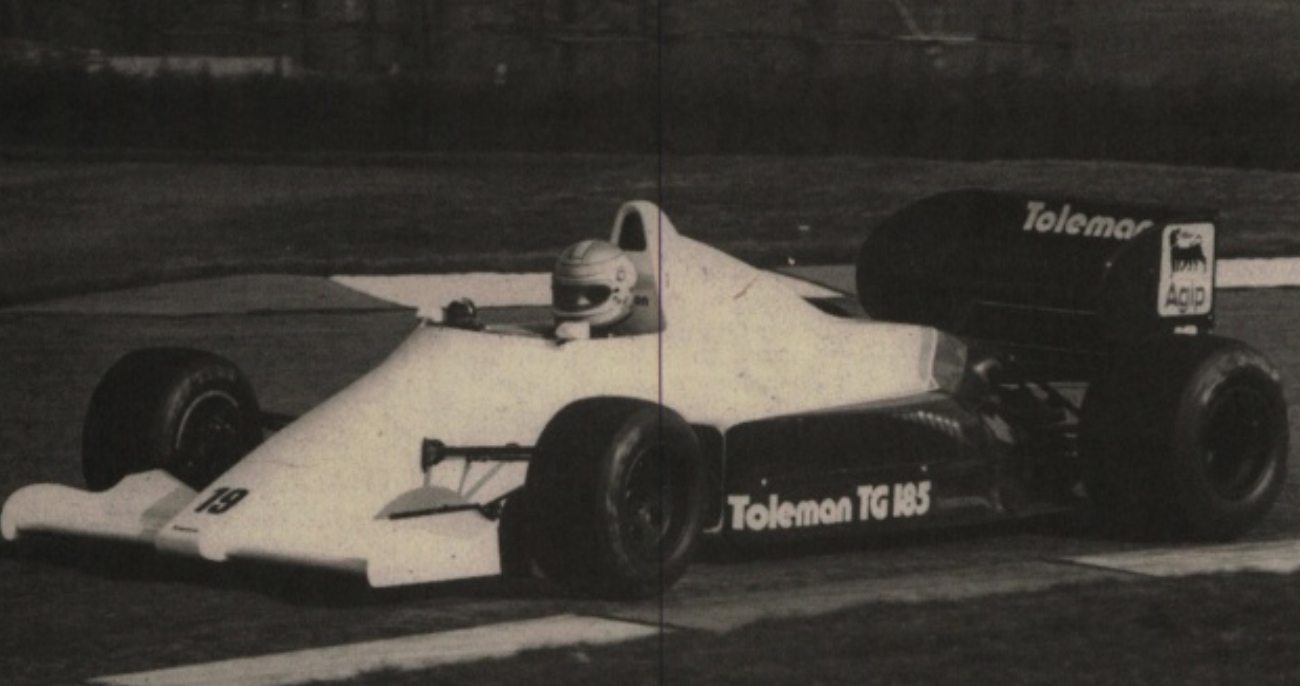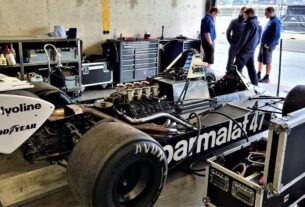It is a cold day in February when rumours appear about John Watson and Toleman. Sacked by McLaren at the end of 1983 in favour of Alain Prost he moved in 1984 towards the World Sportscar Championship with the Rothmans Porsche. For 1985, it seemed to be the World Sportscar Championship again. However, in early February Watson and Hawkridge met each other. A verbal agreement was made a week later, and Watson appeared on the entry list for Toleman published by the FISA in early May. Wattie did fit a seat for the Toleman TG185 at Witney. He was to test with the car soon. Wattie did test with the car, though Toleman Pull out of Formula One only to reappear on the grid in Monaco after Spirit left the Formula One.
It is a sad story of a comeback that didn’t come together due to a simple tyre issue. Toleman had a strong season in 1984 with Ayrton Senna as one of their drivers. Who doesn’t remember Monaco 1984? However, the core of Toleman’s problem was the 1984 San Marino Grand Prix when the team switched from Pirelli towards Michelin. Michelin on their hand announced a few months later that they would retire from Grand Prix racing. Which was a problem for Toleman. Interestingly, they did the same trick with Goodyear when they raced in the Formula Two. When they signed a contract with Pirelli. Having no alternative for 1985, the team would be unable to race next season.
While they had this problem to be solved, they continued working on their challenger for 1985 the TG185. They contracted Stefan Johansson as one of their drivers with one spot still open. Toleman showed the world the Rory Byrne designed, with the help of Symonds and Kelly, TG185 the 15th of January 1985 somewhere in London. The team was positive about their new car, while the engine proved, the Hart L4 Turbo,it was a good fit with the team. The only problem was still the tyres. Neither Goodyear nor Pirelli was able to supply the team with their rubber.
Therefore, Toleman had contact with Yokohama and Bridgestone if they were able to supply them with the rubber. In the meantime, the team appeared the 22nd of January at Silverstone for their shakedown. With the few Pirelli tyres left from last season, Stefan Johansson gave the TG185 the shakedown. Only to puncture one of the tyres after a few rounds. The team decided to call it a day as there was a test session ahead at Silverstone a few days later. Johansson showed the potential of the car. Even on ancient tyres, he was able to set quick time laps. The same time Toleman was on speaking terms with Pirelli. Pirelli kept on saying they were unsure if they had the capacity to supply another team.
In early February, days before the Rio testing, Alex Hawkridge and Chris Witty went to Tokyo to convince Yokohama and Bridgestone to supply them with tyres. Bridgestone was eventually interested. However, stated that it was too early for them.
It is said that Enzo Ferrari himself was involved with Pirelli and Toleman. Because at Rio Toleman had received three new sets from Pirelli. The team arrived at Rio on for hand with their ancient tyres, the same compound from before they switched to Michelin. Enzo Ferrari is probably involved in this as he was interested in hiring Stefan Johansson for his own team. Therefore, he could see at Rio how he went in the new Toleman TG185. The TG185 showed it’s potential during the test session. Noting quick laps. However, the tyre issue still had to be solved.
In the meantime, the second seat at Toleman was still to be filled. While Francois Hesnault and Piercarlo Ghinzani were one of the main candidates, also to lure in Pirelli it was John Watson. In Mid-February, the name of John Watson circulated as the second driver for Toleman in 1985. A driver with that much experience combined with a young talent like Johansson could be a gold combination. Watson and Hawkridge came to a verbal agreement for 1985 with an option for next season. Therefore, John Watson appeared on the entry list as the second Toleman driver the FISA published the 1st of March 1985. It seems that Wattie had already the opportunity to race for Toleman in 1984 according to some sources.
While Watson was announced as second driver for the team, Stefan Johansson appeared with the TG185 at Silverstone. This time fitted with Avon tyres. Toleman had asked Avon Tyres if they were willing to supply them with tyres for the test at Silverstone. This test was used for engine evaluation. Avon left the Formula One after the 1982 season when they supplied ATS, Ensign, March and Theodore. The company used this test on their terms to develop their F3000 tyres they were developing. Johansson completed 65 laps at Silverstone.
John Watson appeared the 12th of March at Toleman’s factory in Witney for a fitting in the TG185. He would test for the first time with the car a few days later. Watson would test with the TG185. However, his comeback in the Formula One was in jeopardy now. Toleman announced it would cease their Formula One operation. After months of negotiating with tyre suppliers, there was no deal. Bridgestone and Yokohama were unable to supply as Pirelli and Michelin did not have the capacity for another team. Another issue was the lack of a main-sponsor for the team.
While with Johansson and Watson as drivers, it wouldn’t be a problem to attract sponsors. Ted Toleman was quoted “Hard and soul destroying” as this harsh decision had to been made. The team was to blame as well as they made their undiplomatic switch from Pirelli towards Michelin during the 1984 season.
It did not meant the end for the team, as soon the team was able to sign a contract with either Goodyear or Pirelli the would appear on the grid. John Watson kept on testing the TG185 at Donington while the team was figuring out to appear at the start of the season in Rio still. For the testing at Donington, the team was using Avon Tyres. How about Avon as their supplier? This was not an option for the company as they only created the tyres for testing purpose and had no active Formula One department to keep on developing the tyres.
Toleman did not appear at Rio for the season opener. To make the matter worse for the team Zakspeed managed to sign a contract with Goodyear. The team was new in the Formula One, and not planning to debut in Rio. However, due to their long relation with Goodyear in other race series the deal was easy done. Toleman also had to release Stefan from it’s contract eventually. At Jacarepaguá he took place behind the wheel of the Tyrrell 012. In the meantime, for the race at Estoril a go was given from Pirelli when Johansson, Gethin, Byrne and Pirelli’s Mario Mezzanotte had a meeting to discuss the supply of tyres. While the truck were on their way, they were called back.
Stefan Johansson however would travel to Estoril as he signed a contract with Ferrari to replace René Arnoux for the rest of the season. He would finish that season twice on the podium while Toleman was struggling badly to even keep the team alive.
John Watson at the same time was seen at the Porsche Factory. In 1984, he already drove with success for them. He would appear at the start of Le Mans as one of the factory drivers with the Rothmans Porsche. While Toleman had to miss races, as they still had no tyres, Watson stayed with the team. However, rumours appeared that Alfa Romeo was on the verge to leave the Formula One. Which gave Toleman some hope on tyres. The rumours went even thus far that Eddy Cheever would join Toleman and Alfa Romeo would merge with Toleman. Problem solved! Sadly, this didn’t happen Alfa Romeo finished the season.
There was another problem solving solution. After the Grand Prix of San Marino the Spirit-Hart team ceased their Formula One activity. Which meant that Toleman had tyres and would be able to race from Monaco on. However, without John Watson he did not appear in the TG185. Benetton also purchased a stake in the team, which resulted in a change of ownership. Teo Fabi appeared in Monaco on the grid for the team. While Ghinzani joined after the German Grand Prix. The team failed to score any point and retired from most of the races.
How about John Watson? He continued racing in 1986 in the IMSA Camel GT Championship. While he would race in 1987 and 1989 for Jaguar in the World Sportscar Championship and appear at Le Mans. While continue racing in the IMSA and World Sportscar Championship the years to follow he was the first drive to test with the Jordan 911. Asked by Eddie Jordan team owner of the the new Jordan Grand Prix team that would debut in 1991. After 1993, he would retire from active racing. He would test for Williams and eventually for Sauber in 1997.


